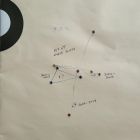Alex Wheeler
Site $$ Sponsor
I like to post targets that are very good examples. And this one is a great example of seating depth at 1k at Deep Creek that Tom Mousel shot tuning before the match. We know +6 shoots and +4 blows up, have not seen +5 yet. Most likely the window is +6-+8 which is very normal for a Vapor Trail in this reamer. Just a good example of why keeping seating depth consistent is so important. 











